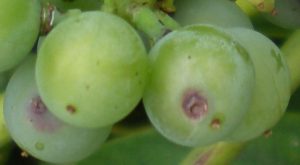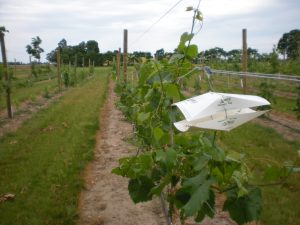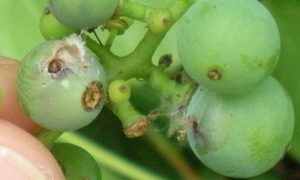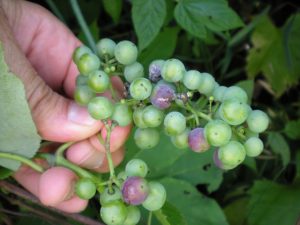Published on
Updated on
Contents:
- Loss of Some Primary Buds to Frost/Freeze Will Result in Asynchronous Bloom
- Cool Wet Conditions Prevail in Forecasts
- Start Planning Immediate Pre-bloom Through Bloom Protective Fungicide Programs
- Commonly Grown Grape Cultivars in Missouri That Are Moderately or Highly Susceptible to Powdery Mildew Erysiphe
- Grape Berry Moth
- Cumulative Growing Degree Days (Base 50) for the Seven Grape Growing Regions of Missouri from April 1 to May 1, 2020
Loss of Some Primary Buds to Frost/Freeze Will Result in Asynchronous Bloom
The frost/freeze events that took place from April 10 through April 18 killed primary shoots on some cultivars (See IPM Report 2020, No. 1). This will result in secondary buds breaking and eventually flowering and producing fruit. With primary shoots flowering in advance of secondary shoots, there will be an extended bloom period. Depending on temperatures the time period between when the primary shoots are blooming and the secondary shoots are blooming could be as long as 14 days. Managing vineyards with different age classes of berries takes considerable more effort compared to vineyards with a single age class of berries. This is because the grape berries develop age-related resistance to the common plant pathogens (Black rot, Downey mildew, and Powdery mildew) 4 to 5 weeks after bloom. With secondary shoots blooming after the primary shoots have bloomed, results in lengthening the window of time when age related resistance develops.
Many of the destructive berry pathogens enter the fruit in the immediate pre-bloom to two weeks post bloom period. If your vineyard lost substantial primary shoots during the frost/freeze events, monitor your vineyards closely to determine immediate pre-bloom and post-bloom fungicide sprays for secondary shoots. If you are using systemic fungicides during these immediate- and post-bloom periods, be sure to rotate different FRAC codes to avoid or delay the development of fungicide resistance. Start planning a spray schedule now.
Cool Wet Conditions Prevail in Forecasts
For the period of May 11-15, 2020:
- Below normal daytime temperatures with highs in the 60s°F and nighttime lows near 45°F. These forecast temperatures are 10 to 15°F below normal.
- Above average precipitation is forecast.
Cool wet conditions favor:
- Botrytis, Botrytis cinerea, is likely more of a threat in vineyards that were damaged by frost/freeze events in April. Botrytis can colonize and reproduce on dead plant tissue as a saprophyte. Botrytis has a wide range of temperatures at which the spores (conidia) can germinate and cause infection from 33°F to 86°F. Scout your frost/freeze damaged vineyards.
- Phomopsis cane and leaf spot, Phomopsis viticola. With cool wet conditions prevailing, Phomopsis will be a continue to be a threat. Once bloom occurs, the spores of Phomopsis decline.
- Powdery mildew Erysiphe nectar is also a potential threat with cool temperatures and humid conditions. Ideal temperatures for powdery mildew are near 68°F. The cool temperatures should keep powdery mildew in check for now. Powdery mildew spores are destroyed by rain events, but powdery mildew thrives in high humidity conditions.
- Black rot Guignardia bidwellii is a continuous threat. The fruit develops resistance to Black rot infections 4 to 5 weeks after bloom. However, all green tissue remains susceptible throughout the growing season.
- Downy mildew Plasmopara viticola is a threat from bud-break until 4 to 5 weeks after bloom. At which time berries develop resistance to downy mildew infection, but all other green tissue remains susceptible until leaf fall.
Start Planning Immediate Pre-bloom Through Bloom Protective Fungicide Programs
Depending on the temperatures and the grape cultivar, grapevines will be entering the immediate pre-bloom period in the next 14 to 21 days. This is a critical time to protect the crop from fungal pathogens. The immediate pre-bloom fungicide application often will include mancozeb tank mixed with another product such as Rally 40WSP or TebuStar 45WSP (There are many generic products of TebuStar.). There are a lot of fungicides to select from during this immediate pre-bloom to bloom time period. Do not use the same systemic fungicides within the same FRAC code consecutively; rotate to another systemic product with a different FRAC code. Keep aware of early and late maturing grape cultivars as to withdraw mancozeb containing products that have a 66 day PHI.
Commonly Grown Grape Cultivars in Missouri That Are Moderately or Highly Susceptible to Powdery Mildew Erysiphe
.
| Cultivar/Species | Susceptible to Powdery Mildew | Sulfur Sensitivity |
|---|---|---|
| Cabernet Franc | Highly susceptible | No |
| Catawba | Moderately susceptible | No |
| Chambourcin | Highly susceptible | Yes |
| Chardonel | Highly susceptible | No |
| Concord | Moderately susceptible | Yes |
| Norton | Moderately susceptible | Yes |
| Seyval | Highly susceptible | No |
| St. Vincent | Moderate susceptible | No |
| Traminette | Moderate susceptible | No |
| Valvin muscat | Moderately susceptible | No |
| Vincent | Moderate susceptible | Unknown |
| Vidal blanc | Highly susceptible | No |
| Vignoles | Highly susceptible | No |
| Vitis vinifera | Highly susceptible | 1No |
1 Be aware there are some exceptions when it comes to Vitis vinifera cultivars, as some cultivars are sensitive to foliar sulfur applications.
Grape Berry Moth

Grape berry moth (GBM) is a native North American pest that can reduce fruit quality both directly and indirectly. The immature or larval stage of the pest tunnels into fruit reducing fruit quality. The entry holes (“stings”) of the larvae compromise the integrity of the berries and provide an entry point for assorted fruit rots including sour rot (Figure 1). There are three generations of GBM. The first generation of GBM appears around 400 cumulative degree days at a base temperature of 47°F. The appearance of the first generation coincides with the bloom of wild grapes. Vineyards that have had consistent year to year problems managing GBM should manage this first generation. Since the emergence of the first generation of GBM coincides with wild grape bloom most of the GBM at this time will be in vineyard perimeters especially near wooded areas. Consider using a number of methods to monitor for the appearance of first generation GBM. Monitor wild grapes for bloom, calculate the number of growing degree days that have accumulated since April 1 at a base temperature of 47°F and monitor the appearance of GBM using pheromone traps.
Get historical weather information from Missouri Mesonet weather stations. Select a weather station that is nearest your vineyard. Select average temperature for the period from April 1, 2016 to present day. Download the information into an excel spreadsheet and subtract 47 from the average temperature for each day. Remember to correct the data that provides negative numbers to zero. Sum the degree days, which is the cumulative degree days that have accumulated since April 1.
Before trying to manage the second or third generations of GBM, you need monitor temperatures, and also understand a bit about the biology of GBM. Rufus Isaacs at Michigan State University (MSU) has shown that GBM takes 810 and 1620 GDD after wild grapes (Vitis riparia) bloom for the second and third generations, respectively to start egg laying. The biofix in this MSU model is the date in which wild grapes are flowering. Flowering is defined when 50% of the inflorescences have 50% of their flowers open. Typically wild grape blooms 8 to 14 days before most of the commercial grape cultivars bloom. Over the years a number of GBM models have been developed that use different biofix dates. For example, male GBM trap captures and degree day accumulations since April 1 and January 1 are common. However, a biofix date based on grape phenology seems to be working more effectively.
Quick Primer on Degree days and Development

Similar to plants, temperature is a driving force in the growth and development of insects. Before moving to insects, let’s first look at grapes. On the last page of this report, I record the number of growing degree days that have accumulated at a base temperature of 50 degrees. The base temperature is the temperature at which no growth takes place. If the average daily temperature is 50 degrees or lower, no degree days accumulate and virtually no growth takes place. In addition to a lower base temperature threshold, often an upper limit temperature threshold is also used in which growth does not take place. In the case of most plants this upper limit is 86 degrees. If you can imagine, once the air temperature hits 86 degrees or above, the stomata’s on the plant close and without gas exchange little or no photosynthesis is occurring and growth stops. Let’s move onto insects where the same principles apply for growth and development. The major difference between insects and grapes is that the base temperatures are different. In fact, entomologists have determined the base temperatures for many insects. Some insect species have the same base temperatures but there is a significant range. It is very important that you use the correct base temperature for the insect that you are trying to monitor. For Grape berry moth the base temperature id 47°F.

Managing GBM
The first generation of grape berry moth typically appears in the vineyard at bloom. If your vineyard has been experiencing severe GBM damage, consider applying an insecticide 10 days post bloom for control. The first generation of GBM is often more of a problem on the perimeter rows in the vineyard. Focus cover sprays on these perimeter rows especially perimeter rows that are along wooded areas.

Second and third generation GBM can be managed by timing insecticide sprays based on the degree day model. Since the model predicts the egg laying of GBM, you have to consider your insecticide options. Altacor and Intrepid should be applied at 810 and 1620 GDD after bloom of wild grape. These insecticides need to be applied at the egg hatch or newly hatched larval stage of GBM. Both of these insecticides are considered reduced risk pesticides. Intrepid will only control Lepidopterous larvae and therefore will preserve natural enemies. Both Altocor and Intrepid have long residual control of GBM. If using broad-spectrum insecticides (Sevin XLR, Brigade or others), the insecticide should be applied at 910 and 1720 GDD after wild grape bloom. The latter applications of these broad-spectrum insecticides are targeting larva at various stages in their development.

Scouting and Monitoring for GBM
Pheromone traps should be placed in the vineyards in early April. There are a number of suppliers. Traps should be placed within the grape canopy. When placing traps, make sure that adult moths have a direct path into the trap (Figure 1). Remove grape leaves or trim shoots that obstruct entry into the trap. It is also important to monitor developing grape clusters for GBM damage. A telltale sign of a GBM damage are “stings” (Figure 2) white webbing with two or more berries webbed together (Figure 3). This webbing often has small specs of early instar GBM frass. On red berried cultivars another telltale sign of GBM is early coloration of the berries well before the onset of veraison. In addition, the first generation pupae of GBM will often be found on leaves in which the leaf edges have been rolled under by the larvae before pupation.
Cumulative Growing Degree Days (Base 50) for the Seven Grape Growing Regions of Missouri from April 1 to May 1, 2020
| Region | Location by County | Growing Degree Days1 | ||
|---|---|---|---|---|
| 2020 | 2019 | 30-year Average | ||
| Augusta | St. Charles | 231 | 302 | 302 |
| Hermann | Gasconade | 225 | 310 | 294 |
| Ozark Highland | Phelps | 229 | 348 | 313 |
| Ozark Mountain | Lawrence | 254 | 341 | 305 |
| Southeast | Ste. Genevieve | 229 | 330 | 314 |
| Central | Boone | 229 | 298 | 276 |
| Western | Ray | 228 | 265 | 262 |
1 Growing degree days at base 50 from April 1 to May 1, 2020. Data compiled from Useful and Useable at U2U Tools Website. Click on link to determine growing degree days in your area.
To determine the number of growing degree days accumulated in your area since April 1, use this tool.